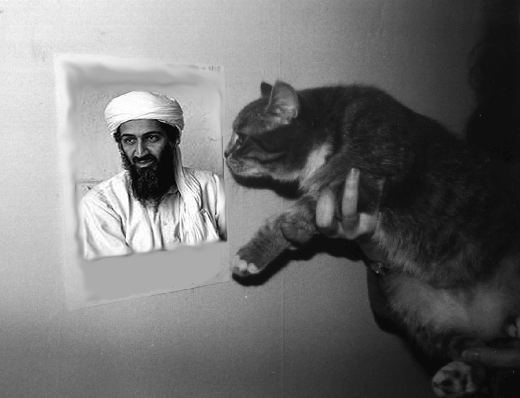Feline Reactions to Bearded Men of Beard Type #55G
by Alice Shirrell Kaswell, AIR staff
Figure 1. A feline subject reacts to a photograph of a man with a beard of
Type #55G.
Abstract
This is a new item in the continuing series of reports on the topic "Feline Reactions to Bearded Men." This report concerns experiments with feline reactions to photographs of men of Beard Type #55G
In the project, cats were exposed to photographs of bearded men. The beards were of various sizes, shapes, and styles. The cats' responses were recorded and analyzed. (For details, see the initial report in the series, "Feline Reactions to Bearded Men," by Maloney et al. and subsequent reports by the same and other teams.)
UPDATE: November 2001
We have begun a new series of experiments in which cats are exposed to bearded men with a beard type (International Beard Classification Type #5G) that was not previously included in the investigations.
Figure 1 is a photograph of the work as it was carried out in our laboratory.
In subsequent updates we will publish our full results and conclusions. This is a preliminary report.
Materials
Five photographs were used in the study. The photographs, reproduced here, display a range of different types of bearded men of Beard Type #55G.The test subjects were female cats, all between the ages of four and six. 231 cats participated in the study. Six cats died during the study, due to causes unrelated to the bearded men. Twelve cats gave birth while viewing the photographs.
Methods
Each cat was exposed to the photographs. One photograph was shown at a time. Each photograph was visible for a span of twenty seconds. The photographs were presented in the same order to each cat.While each cat was viewing the photographs, it was held by a laboratory assistant. To ensure that the cats were not influenced by stroking or other unconscious cues from the assistant, the assistant was anesthetized prior to each session. The cats' reactions were assessed for changes in pulse rate, respiration, eye dilation, fur shed rate, and qualitative behavior.
Results
The results are Table 1 are for Subject #4 (see photograph) of this phase of the study. The quantitative results are average values calculated over the entire feline subject population. The qualitative results are broken out by percentages of the subject population.Table 1
BEARD TYPE #5G, SUBJECT #42
Pulse Rate: +84%
Respiration: +317%
Eye Dilation: +4%
Fur shed rate: 12%
Qualitative Behavior:
38% attacked photograph; hissing; spitting;generally agitated behavior.
29% fled.
33% had no visible response.
Interpretation
- Cats do not like men with long beards, especially long dark beards.
- Cats are indifferent to men with shorter beards.
- Cats are confused and/or disturbed by men with beards that are incomplete (e.g., Bork -- see original report) and to a lesser degree by men whose beards have missing parts (e.g., Crafts -- see original report) or are of International Beard Classification Type #5G.
- We caution that these results are still preliminary.
NOTES:
1. A copy of the original report is posted on the Annals of Improbable Research (AIR) web site.
2. The authors have published a series of
reports, and are continuing their research.
For an interim report (including newly discovered historical photos
of cats reacting to Abraham Lincoln, Csar Nicholas, and others)
see the Sept./Oct. 1999 issue
(vol. 5, no. 5) of the Annals of Improbable Research.
Further reports appear in many of the subsequent
issues of the magazine.
HOME > AIRCHIVES > CLASSICAL GAS > Feline Reactions to Bearded Men of Beard Type #55G